The Thanos Imperative HC (Marvel, $24.99)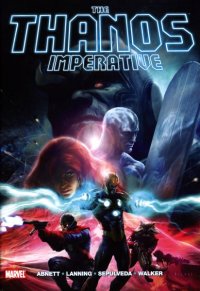
Annihilators #1 (Marvel, $4.99)
by Graig Kent
Dan Abnett and Andy Lanning (the writing team colloquially known as “DnA”) were with the Marvel Cosmic rebirth from the beginning, working on the Annihilation:Nova mini-series that accompanied Keith Giffen’s epic Annihilation event, in the process making Nova less the butt of “bucket-head” jokes and more a visible and undeniable powerhouse in the Marvel Universe. Following Annihilation, DnA spun Nova off into his own series, redefining the character and the Nova Corps group of space police as something other than a pale imitation of the Green Lanterns, as well as furthering the Marvel Cosmic/Annihilation brand, leading directly into the second epic, Annihilation: Conquest. From this, DnA spun off a revamped Guardians of the Galaxy ongoing, acting as a sister title to Nova, and allowed them to simultaneously, but mutually exclusively build towards their next epic, War of Kings conflict between various alien empires. The War of Kings burst a seam in the fabric of space, leading to Realm of Kings, wherein it’s revealed there’s nasty stuff on the other side of that tear in space, and through the two ongoing series and a group of one-shots and mini-series, DnA started building to their climax: The Thanos Imperative.
On the other side of that fault is what has been dubbed the Cancerverse (or, elsewhere, the Cthulhuverse), and as much absolutely terrific stuff as DnA have done over the past few years with Marvel Cosmic, this is the most wonderful invention of all. The Cancerverse is another of Marvel’s alternate dimensions, only in this universe their Mar-Vell had not only conquered Death, but utterly obliterated it such that no one in that universe dies anymore. This has lead to a universe teeming with life, mutated in grotesque and horrifying ways, and in general corrupted the entire universe. Life, so often decreed the most important thing of all, no longer seems so positive.
With the Cancerverse literally bursting at the seams with the undying, the fault between their reality and the Marvel 616 reality has given them the opportunity to expand, and naturally it’s up to the heroes cosmic to stop them. But how do you defeat an enemy that cannot die? The title makes it obvious: Thanos, avatar of Death. He is their only weapon, but the question is can they trust him (hint: he’s Thanos, of course not), and can they stop him if they need to (hint: unlikely). As high-stakes as Annihilation and the subsequent cosmic events have been, they quite literally have never been higher.
The Thanos Imperative is an incredible payoff for an already incalculably rewarding run from DnA. Without diminishing any of the prior events that they’ve spearheaded or supported, DnA managed to envelop the major moments of those and use them as landmarks in the path to this ultimate battle. Epic doesn’t begin to describe it. On its own The Thanos Imperative is morosely clever, utterly enthralling, and unbelievably awesome, it epitomizes what can be done within the confines of a shared universe, and maximizes the history that’s been laid down before it without wallowing in it. There’s hardly a single misstep with this final act, with main art chores handled by Miguel Sepulveda capturing all the grotesqueness and danger of the Cancerverse and the massive power of the Celestials, managing every huge moment (of which there are dozens) as capably as every small character beat. It’s an absolutely spectacular read on every level, showcasing what comics can do that no other media can.
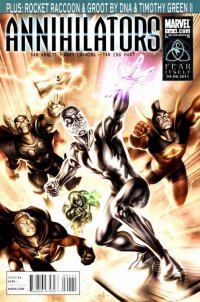 But The Thanos Imperative is not the final chapter of DnA’s Cosmic run, with their new mini-series, Annihilators, acting as coda to their past five years’ work. Annihilators is an attempt at making an “Avengers”-like team for space, bringing together the “big guns” (Silver Surfer, Ronan the Accuser, Quasar, etc) on one team to act as guardians of the galaxy who have an actual threat level. It’s not a bad idea, frankly, but at the same time, unlike how Nova or Guardians of the Galaxy spun-off from prior events, it feels less earned. Nova and the Guardians had been central figures in these major epics, but from their perspective we understood how a “normal” person could become a hero and affect change amidst a greater battle. The Annihilators aren’t normal people, and the feeling is they can affect change all by themselves. Quasar, here subbing in for Nova, doesn’t make (nor has he really ever made) for a particularly relatable hero, his self doubt I guess is earned but our exposure to him over the previous series hasn’t prepared us for his role as guide into the new Marvel Comsic mega-team. As well, I also have a problem seeing these titans sit around in casual quarters debating with one another, as it feels less than natural. I mean, I guess it would happen, but it doesn’t seem like it should. In spite of this, Annihilators isn’t a bad book, it’s just a hard transition from the sweeping scale that’ had preceded it. Tan Eng Huat provides some gorgeous, richly detailed and often playful art, giving it a stimulating appearance, and a (quite needed) less sever tone.
But The Thanos Imperative is not the final chapter of DnA’s Cosmic run, with their new mini-series, Annihilators, acting as coda to their past five years’ work. Annihilators is an attempt at making an “Avengers”-like team for space, bringing together the “big guns” (Silver Surfer, Ronan the Accuser, Quasar, etc) on one team to act as guardians of the galaxy who have an actual threat level. It’s not a bad idea, frankly, but at the same time, unlike how Nova or Guardians of the Galaxy spun-off from prior events, it feels less earned. Nova and the Guardians had been central figures in these major epics, but from their perspective we understood how a “normal” person could become a hero and affect change amidst a greater battle. The Annihilators aren’t normal people, and the feeling is they can affect change all by themselves. Quasar, here subbing in for Nova, doesn’t make (nor has he really ever made) for a particularly relatable hero, his self doubt I guess is earned but our exposure to him over the previous series hasn’t prepared us for his role as guide into the new Marvel Comsic mega-team. As well, I also have a problem seeing these titans sit around in casual quarters debating with one another, as it feels less than natural. I mean, I guess it would happen, but it doesn’t seem like it should. In spite of this, Annihilators isn’t a bad book, it’s just a hard transition from the sweeping scale that’ had preceded it. Tan Eng Huat provides some gorgeous, richly detailed and often playful art, giving it a stimulating appearance, and a (quite needed) less sever tone.
But the “Annihilators” team isn’t the only focus of this mini-series, as DnA wrap in a second-series as co-feature, catching up with Guardians of the Galaxy fan-favourites Rocket Raccoon and Groot following the dismantling of their team and redefining their place in the universe. Illustrated by Timothy Green III (himself no stranger to the Marvel Cosmic, having illustrated the Annihilation: Conquest: Star Lord mini a few years back), he compliments DnA’s lighter-hearted take on Rocky with a more cartoonish sensibility. Whimsical likely best describes this back-up, but with Rocket Raccoon as your lead, of course it should be. He’s a ridiculous character, but given respect in spite of it, and it works. It’s quite a disparate story than the lead feature, much smaller and character focused in scale, but not uncomplimentary.
I believe word is that DnA are closing up shop on their Marvel Cosmic run after this, which means they’re not going out on top, but they’re not going quietly either. If what came before was the marathon, Annihilators is the cool-down afterwards.
The Thanos Imperative HC : Rating: 




Out of a Possible 5 Stars
Annihilators: Rating:





Out of a Possible 5 Stars
Sigil #1, Crossgen/Marvel, $2.99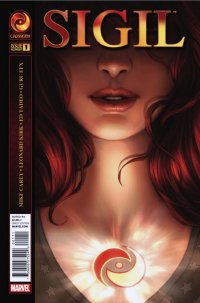
By Adam Prosser
The concept of an interlinked “universe” of comics titles is still something of a holy grail for fans, creatives, and publishers. It’s an extremely satisfying narrative conceit, when done properly, and it lends itself to all kinds of interesting experiments with storytelling. Plus, of course, it makes it easy for the various comics to plug each other, via guest appearances and linked storylines, thereby, presumably, increasing sales across the whole line. But as large as this concept looms over the history of comics, the number of times that a “crossover” universe has been both creatively and financially successful can be counted on one hand.
At the tail end of the 90s, CrossGen comics was launched by entrepreneur Mark Alessi with an ambitious plan to launch a new comics line. On paper, there were a lot of good ideas here: CrossGen hired some of the top talent in the comics field to produce an array of titles across many different genres, smartly steering clear of superheroes to focus on fantasy, epic SF, and a handful of quirky genres (like the supernatural Sherlock Holmes pastiche Ruse and the martial arts comedy The Way of the Rat) that were underserved in comics at that point. There was an underlying meta-story involving mysterious Sigils, chronicled in a couple of key books, but it didn’t intrude much on the individual series. And indeed, CrossGen stuck around for several years, publishing a substantial number of issues, and to this day many of their books are remembered fondly. Nevertheless, CrossGen declared bankruptcy in 2004, for reasons that remain unclear. Was CrossGen a bad idea, or was it a good idea that fell prey to other factors?
Marvel apparently intends to find out, having procured the license to CrossGen’s titles, with the plan of using the imprint to add some non-superhero books to their roster. They’re rolling it out rather less ambitiously than did CrossGen, starting with a reboot of their core book, Sigil. I’ll confess right now that while I checked out some of the original CrossGen titles, I stayed away from the “Sigilverse” metaplot, so I have nothing to compare this to. Fortunately, my research makes it pretty obvious that this book has been completely revamped from its original format. Unfortunately, the results seem to be rather less interesting, at least at first.
In this incarnation, the book centers around Samantha “Sam” Rey, your standard snarky teenager with Pretty White Girl Problems, ranging from the relatable (her mother’s death is creating a rift between herself and her father) to the bizarre (a gang of tough-girl bullies, one of whom has, I shit you not, a pink Mohawk) who discovers that the Sigil birthmark means that she’s the chosen one and blah blah blah. While I understand that there’s a need to make characters relatable, and that Marvel obviously wants the teen audience back, it really is starting to seem like every second new comic I read starts with this same wannabe Harry Potter Heroes’ Journey bullshit, and frankly it’s all starting to blend together. So that’s a pretty big strike up front.
Fortunately, things do start to get more interesting by the end, as Sam’s Sigil transports her to the deck of a 17th century pirate ship, El Cazador (the subject of one of CrossGen’s most popular later titles) and sets up a time-travelling adventure story. CrossGen was originally based around a “multiverse” of alternate realities, one for each title, and with the Sigils apparently able to cross over between them, so to speak. It looks like the new CrossGen may be doing away with the multiverse aspect, replacing it with time travel, but we’ll have to wait and see.
The issue is written by Mike Carey, a guy who I run hot and cold on. He can be very good, but he can also come off as a pale shadow of Neil Gaiman, and his pacing is sometimes too deliberate, as witnessed here with a story that takes way too long to get to the adventure stuff. Sam’s a relatively strong personality, but she’s also a really blatant Buffy clone, which doesn’t help with the stench of familiarity wafting from this book.
Honestly, while there’s quite a bit that captures my interest here, it’s only because of my passing familiarity with CrossGen, as mentioned above. I personally think the idea of CrossGen is something that could really work, given a proper do-over, but it needs a certain level of ambition. Yet it’s ambition that seems to have hurt, if not outright killed, CrossGen in the first place, so I suppose I can’t blame them for ramping things back a little. Still, if I was a new reader who knew nothing about CrossGen, I’d look at this book and I’d see a really generic teenage fantasy adventure, andthat needs to change, fast. When CrossGen first arose, it was a standout in a market that may not have been able to support it; the irony may be that now, with a potentially more stable framework, the new CrossGen is in danger of fading into the background.
Rating: 




Out of a Possible 5 Stars
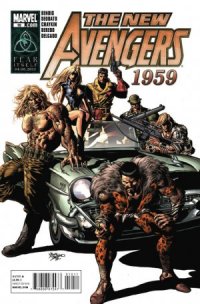 New Avengers #10 (Marvel, $3.99)
New Avengers #10 (Marvel, $3.99)
By Devon Sanders
I’m a sucker for things that makes you wish you’d thought of it. Things like Google. Putting water in plastic bottles and selling it. Nick Fury leading a super-powered black-ops team in 1959 Cuba. An Avengers before The Avengers. I love this stuff, the idea BEFORE the idea. Speculative superhero fiction made canon. Marvel’s The Twelve and Agents of Atlas. DC’s All-Star Squadron, that sort of stuff. I love it, especially when it’s done well. New Avengers #10 is done well. The current-day New Avengers are in battle, on the cusp of learning a secret long thought buried by Nick Fury. Meanwhile, in ’59, Fury puts together a team of adventurers including Sabretooth, Namora, Kraven The Hunter, Dominic Fortune, Bloodstone & Silver Sable to bury said secret.
Written by Brian Michael Bendis, New Avengers #10 is one of the better books I’ve seen from him in a while. The plot is fun and the pacing between the current and ’59 Avengers is tight and engaging. Artists Mike Deodato and Howard Chaykin handle the current and ’59 Avengers, respectively and both bring their cosidered best. Deodato is the consummate superhero artist, filling the page with plenty of rippling muscles, dramatic flourishes and layouts that appropriately draw the eye in to the action while Chaykin illustrates the elegance and sometimes, roughness of this “lost” Avengers tale set in the past. New Avengers #10 is the rare Marvel comic that actually looks like a great jumping-on point and is.
Rating: 




Out of a Possible 5 Stars
Punisher MAX #11 (Marvel, $3.99)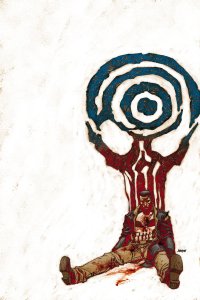
By Jeb D.
During his Punisher MAX run, Jason Aaron has done a great job at fleshing out The Kingpin, making his carryover from the regular Marvel U not only more or less plausible, but with a level of characterization that is the equal of what we saw from Bendis and Brubaker, but in a wholly different direction. And the delight of this current arc has been watching Wilson Fisk come to the realization that his abilitities to manipulate and intimidate have met their match: in Bullseye, he’s found a weapon that he doesn’t understand and can’t control. And in the end, the inevitable showdown between Bullseye and Frank Castle reaches its bloody conclusion at The Kingpin’s meaty hands.
That showdown is the focus of this climactic issue, and it’s every bit as grotesque as you’d expect (if I’ve seen a hand-to-hand fight in a comic before that included one character vomiting on another, I’ve suppressed it); if you’ve been waiting to see just how far Aaron and artist Steve Dillon were prepared to go, you won’t be disappointed (Bullseye has a nail or two drilled into his forehead, and proceeds on as if nothing has happened).
If you’re a fan of Frank Castle, though, you might be. Because, just as Fisk has been the essential protagonist for most of this story arc, in this final issue, Frank’s little more than the sort of dangerous killing machine that provides the Last Big Fight in your Lethal Weapon/Die Hard films, but is never the principal antagonist. While Bullseye continues his attempt to sort out the great Punisher retcon (demonstrating that an attempt to reconcile the classic Punisher story with Ennis’ Born, as well as the passage of decades since Vietnam, seems like an exercise designed to end in failure and frustration), ruminating on Frank’s “hidden secret” as he dispatches Fisk’s goons with ease, Frank does little but grunt (I’d love to know just how Aaron decides precisely where each “Ngh” and “Grrr” is to be placed).
And for all the climactic nature of Aaron and Dillon’s presentation here, in the end, an awful lot is left unresolved, particularly considering that in the narrow confines of the MAX universe, with its limited need to keep popular characters in the forefront, we ought to be able to get some finality. Certainly, Frank’s reaction to Bullseye finally (after several pages of talking about it) whispering the secret into his ear (alone) suggests that he’s hit even more nerves than were severed during the fight, but we’ll have to come back another time to find out just what it is.
Since this title is consistently strong enough to be worth regular purchase, I can’t feel too bad about having to wait till next issue to see if Aaron peels off a few more secrets. Otherwise, though, it’s lots of blood and guts, but a little shy in the story department.
Rating: 




Out of a Possible 5 Stars